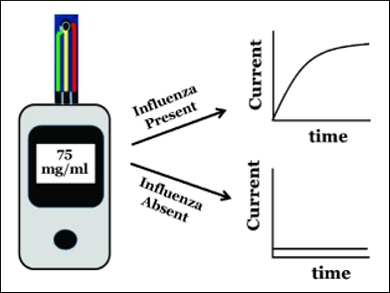Detecting Influenza Quickly and Reliably
Almost every winter sees a new wave of influenza, threatening people by its highly contagious character and severe pathogenesis if those with weak or compromised immune system are infected. But when do sniffing and high temperature only point to a bad cold and when is it real influenza? American scientists have developed a simple system for testing for the influenza virus by just taking nasal or throat swabs and measuring the viral presence amperometrically by assessing the glucose level. This assay design is presented in the journal Angewandte Chemie.
During their search for novel and simple viral diagnostic tools, chemist Suri S. Iyer and his team from Georgia State University became extremely interested in neuraminidase glycoprotein. This viral enzyme cleaves sialic acid molecules of the host cell to release viral progeny into the blood. With the aim to “develop substrates that would release glucose upon action of neuraminidase,” the scientists made use of this neuraminidase cleavage reaction. The released glucose molecules were measured electrochemically, giving a quantitative report on the presence of the virus.
Using Glucose for Inexpensive and Sensitive Diagnostics
Iyer chose glucose as the target molecule because “glucose meters are affordable, sensitive, specific for glucose, user-friendly, rapid, and portable,” he says. He wants to simply repurpose these glucose meters for integration of the neuraminidase (or virus) assay. “Simplicity is very important for market adoption,” says Iyer.
With this aim, Iyer’s team designed a substrate molecule for viral neuraminidase, which has the glucose molecule chemically attached. This sialic acid derivative, known as SG1, was accepted as a substrate by neuraminidases from different viral strains. The cleaved glucose molecules were easily detected in an electrochemical cell. Even on addition of whole viruses of several strains, the level of released glucose could be measured quantitatively, which was also validated by rRT–PCR and plaque assays. In contrast, samples of nasal or throat swabs of healthy volunteers did not lead to a rising level of glucose, which means the assay system only responded to the virus. Iyer also points to an added advantage of using glycans, namely, their stability and extended shelf life, which is very useful for testing in resource-poor remote areas. Furthermore, drug susceptibility could also be monitored, as no glucose was released upon addition of inhibitors.
Given the advantages of a rapid, inexpensive, and sensitive assay for influenza, Iyer is eager to apply the novel system on real conditions. “We have a long way to go, but this is a good first step. In the coming months, we will be testing samples from patients suspected of influenza infection and, in parallel, improve the assay,” he says.
- Electrochemical Assay to Detect Influenza Viruses and Measure Drug Susceptibility,
Xiaohu Zhang, Abasaheb N. Dhawane, Joyce Sweeney, Yun He, Mugdha Vasireddi, Suri S. Iyer,
Angew. Chem. Int. Ed. 2015.
DOI: 10.1002/anie.201412164




